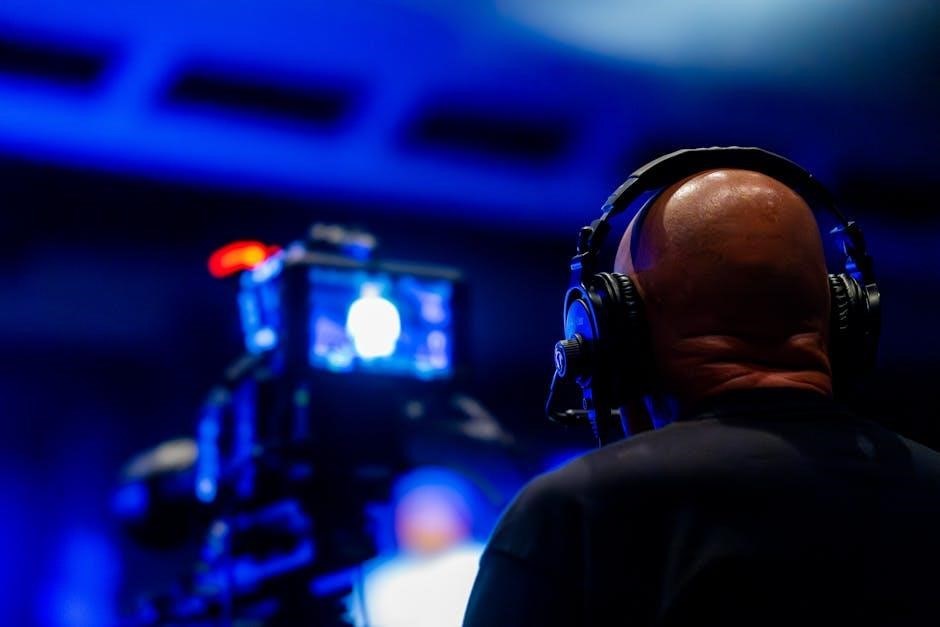The League of Denial documentary explores the NFL’s handling of concussions and brain injuries, revealing the hidden story of CTE’s impact on players. This guide provides structured questions and vocabulary to facilitate deeper understanding and critical analysis of the film’s key themes and revelations.
Purpose and Structure of the Guide
The purpose of the League of Denial video guide is to provide a comprehensive framework for understanding the documentary’s exploration of concussions, CTE, and the NFL’s response. Structured into four parts, the guide breaks down the film into digestible segments, each accompanied by guided questions and vocabulary terms. This design encourages critical thinking and analysis, making it an invaluable resource for educational settings. The guide is tailored for students and educators, offering a clear roadmap to engage with the documentary’s complex themes. By dividing the content into focused sections, it ensures a systematic approach to learning about the NFL’s handling of brain injuries, Dr. Omalu’s discoveries, and the broader implications for football culture and player safety. The guide’s structured format facilitates meaningful discussions and reflections, enhancing the learning experience.

Part I: Mike Webster
Mike Webster, a legendary NFL player, faced severe health declines post-retirement, highlighting the devastating effects of repeated concussions and the emergence of CTE, a crisis the documentary underscores.
Background and Career Highlights

Mike Webster, known as “Iron Mike,” was a legendary NFL player whose career spanned 17 years, primarily with the Pittsburgh Steelers. He played in over 200 games, earning nine Pro Bowl selections and four Super Bowl rings. Webster’s relentless work ethic and durability made him a cornerstone of the Steelers’ offensive line during their dominant 1970s era. After retiring in 1991, Webster’s life took a tragic turn as he struggled with cognitive and physical decline, later linked to chronic traumatic encephalopathy (CTE). His story, as highlighted in League of Denial, underscores the long-term consequences of repeated head trauma in football. Webster’s career achievements contrast sharply with his post-retirement struggles, making his case a pivotal moment in the concussion crisis discussion.
The Impact of Concussions on His Health
Mike Webster’s career was marked by thousands of helmet hits, leading to severe health consequences post-retirement. He experienced memory loss, depression, and erratic behavior, symptoms later linked to chronic traumatic encephalopathy (CTE). Webster’s brain was studied by Dr. Bennet Omalu, who identified CTE, a degenerative brain disease caused by repeated head trauma. The documentary highlights how Webster’s condition deteriorated, affecting his personal life and ultimately leading to his death in 2002. His case became a catalyst for understanding the long-term effects of concussions in football, revealing the devastating toll on players’ mental and physical health. Webster’s story underscores the critical need for improved player safety and concussion protocols in the NFL.

Questions and Key Takeaways
Key questions arise from Mike Webster’s story: How did repeated concussions contribute to his mental and physical decline? What role did the NFL play in addressing player health during his career? The documentary raises ethical concerns about the league’s responsibility to protect players; A critical takeaway is the lasting impact of Webster’s case on CTE research and NFL policies. His story highlights the importance of prioritizing player safety and transparency in addressing long-term health risks. These questions and insights encourage viewers to reflect on the broader implications of football’s culture and the need for accountability in safeguarding athletes’ well-being.
Part II: The Growth of the NFL and Dr. Omalu’s Research
The NFL’s rise to cultural dominance is explored alongside Dr. Omalu’s groundbreaking discovery of CTE, linking football’s popularity to emerging health concerns for players.

The NFL’s Rise and Cultural Impact

The NFL’s ascent to becoming a cultural powerhouse is a central theme in League of Denial. The league’s growth into a multibillion-dollar industry was fueled by its ability to market itself as a symbol of American values, entertainment, and community. Its rise coincided with the increasing popularity of football as a national pastime, with games becoming events that brought people together. The NFL’s strategic branding, including its emphasis on player personalities and iconic teams, helped cement its place in American culture. However, this success also led to a lack of transparency regarding player safety, as the league prioritized its image over the well-being of its athletes. The documentary highlights how the NFL’s cultural dominance contributed to a reluctance to acknowledge the long-term health consequences of repeated head injuries, setting the stage for the controversy surrounding concussions and CTE.
Dr. Omalu’s Discovery of CTE
Dr. Bennet Omalu’s groundbreaking discovery of Chronic Traumatic Encephalopathy (CTE) in NFL players marked a pivotal moment in the concussion crisis. While examining the brain of former Steelers player Mike Webster, Omalu identified abnormal tau protein deposits linked to repeated head trauma. His findings revealed a direct connection between football-related concussions and long-term brain damage. Despite the significance of his work, the NFL initially dismissed and discredited Omalu, attempting to undermine his research. This backlash highlighted the league’s reluctance to acknowledge the severity of the issue. Omalu’s discovery not only challenged the NFL’s stance on player safety but also sparked a national conversation about the risks of contact sports. His work laid the foundation for future research into CTE, ultimately changing how the medical and sports communities understand and address brain injuries in athletes.
Questions on the NFL’s Knowledge and Response
Key questions arise about the NFL’s awareness of concussion risks and their response to emerging research. When did the NFL first learn about the link between repeated head trauma and long-term brain damage? Why did the league deny the science behind CTE for so long? The NFL’s Mild Traumatic Brain Injury Committee, established in 1994, claimed there was no conclusive evidence linking concussions to brain damage, despite growing medical consensus. This denial raises ethical concerns about prioritizing player safety over profit. How did the NFL’s actions impact public perception of the issue? The league’s resistance to acknowledging CTE underscores a broader debate about accountability in sports organizations. These questions challenge viewers to critically evaluate the NFL’s role in addressing player health and safety.

Part III: The NFL’s Response to Concussions
The NFL’s response to concussions involved a smear campaign against Dr. Omalu, dismissing his CTE research to protect their image and profits, raising ethical concerns about player safety.

The Smear Campaign Against Dr. Omalu
The NFL launched a targeted smear campaign against Dr. Bennet Omalu after his groundbreaking discovery of CTE in Mike Webster’s brain. The league sought to discredit his research, questioning his credibility and the validity of his findings. This effort aimed to protect the NFL’s image and avoid liability for player brain injuries. By undermining Omalu’s work, the NFL delayed public awareness of the dangers of repeated head trauma in football. The campaign not only affected Omalu’s reputation but also hindered progress in addressing the health crisis facing players. Despite the backlash, Omalu’s work remains pivotal in understanding CTE and its implications for athlete safety. His resilience in the face of opposition highlights the broader struggle for truth in the NFL’s handling of concussions.
Implications of Dr. Omalu’s Work
Dr. Bennet Omalu’s discovery of CTE in Mike Webster’s brain marked a turning point in understanding the long-term effects of repeated head trauma in football. His research revealed that concussions could lead to severe brain damage, challenging the NFL’s longstanding denial of the issue. Omalu’s findings sparked widespread concern, prompting debates about player safety, the ethics of contact sports, and the NFL’s responsibility to protect athletes. His work also led to significant changes in how the NFL addresses concussions, including rule modifications and improved safety protocols. Beyond football, Omalu’s research raised awareness about brain health in other contact sports and military settings. Despite facing intense backlash, Omalu’s contributions remain crucial in the ongoing fight to protect athletes from the devastating consequences of CTE.
Questions on the NFL’s Conference and Findings
The NFL’s conference and findings raise critical questions about their awareness and response to concussion-related issues. What did the NFL know about the link between concussions and brain diseases, and when did they know it? How did their public statements align with internal research findings? The conference highlighted the NFL’s acknowledgment of some connection between head injuries and long-term brain damage, but critics argue this was a strategic move to mitigate growing public and legal pressure. Did the NFL’s actions reflect a genuine commitment to player safety, or were they aimed at protecting the league’s image and financial interests? How did these findings impact public perception of the NFL and its handling of player health? These questions underscore the tension between the NFL’s responsibilities to players and its role as a multibillion-dollar industry.
Part IV: Revival with Dr. McKee and Robert Nuwinski
Dr. Ann McKee and Robert Nuwinski’s groundbreaking research on CTE revitalized awareness of football’s health risks, leading to safer practices and a cultural shift in how the sport is perceived.
Contributions to CTE Research

Dr. Ann McKee and Robert Nuwinski played pivotal roles in advancing CTE research, leading a team at Boston University’s Center for the Study of Traumatic Encephalopathy. Their work involved meticulous analysis of brain tissue from deceased NFL players, identifying patterns of tau protein buildup linked to repeated head trauma. By documenting these findings, they provided irrefutable scientific evidence of CTE’s existence and its connection to football-related injuries. Their research not only deepened the medical community’s understanding of the disease but also raised public awareness, prompting critical discussions about player safety. The implications of their work extended beyond academia, influencing the NFL’s eventual acknowledgment of CTE and its commitment to implementing safety protocols. Their contributions remain foundational in the ongoing effort to protect athletes and address the long-term health consequences of contact sports.
Impact on Football Safety and Culture
The revelations from CTE research have profoundly influenced football safety and culture, prompting significant changes in how the sport is played and perceived. The NFL implemented stricter concussion protocols, including independent medical spotters and enhanced return-to-play guidelines, to better protect players. Rule modifications, such as penalizing helmet-to-helmet hits, aim to reduce head trauma. Youth football programs have adopted safer practices, with some banning full-contact drills for younger athletes. Culturally, the documentary sparked a national conversation about the sport’s risks, leading to increased parental scrutiny and declining participation in youth leagues. Players now prioritize long-term health over career longevity, and public perception of football has shifted, balancing admiration for the game with awareness of its dangers. These changes reflect a growing emphasis on player safety and accountability, reshaping football’s future while addressing its past oversights.
Questions on the Future of Football
The documentary raises critical questions about football’s future, including whether the sport can sustain itself amid growing concerns about player safety and long-term health risks. Will rule changes, such as eliminating certain types of hits, fundamentally alter the game? How might advancements in helmet technology or concussion protocols mitigate risks? Could shifting public perception lead to declining participation in youth football? What role will parents, schools, and leagues play in balancing the benefits of football with its potential dangers? Additionally, how might the NFL’s response to CTE research influence its reputation and fan engagement? These questions prompt a broader discussion about the sport’s evolution, emphasizing the need for innovation and accountability to ensure football’s survival while prioritizing player well-being.
The documentary and guide reveal the NFL’s role in hiding concussion risks, sparking crucial discussions on player safety and the sport’s future, emphasizing accountability in sports.

Significance and Lasting Impact of the Documentary
League of Denial has profoundly impacted public perception of football, exposing the NFL’s handling of concussions and CTE. By revealing the league’s negligence and the devastating effects on players, the documentary sparked national discussions on player safety, ethics, and the sport’s future. Its findings led to rule changes, increased medical research, and heightened awareness among athletes, parents, and fans. The accompanying guide enhances understanding through structured questions, fostering critical thinking about the NFL’s responsibilities and the sport’s cultural significance. The documentary’s legacy lies in its ability to challenge the status quo, prompting a cultural shift toward prioritizing player health. Its influence continues to resonate, ensuring that the conversation about football’s risks and reforms remains ongoing.



